Welcome to our comprehensive guide on integrating Django Bootstrap Pagination into your web projects. As you embark on this journey, know that this valuable tool has served its purpose well but is now archived and no longer actively maintained. Nevertheless, with our guide, you can easily learn how to set it up and troubleshoot any issues along the way!
Understanding Django Bootstrap Pagination
Think of Django Bootstrap Pagination as a neatly organized bookshelf that helps house visitors navigate through pages seamlessly. Just as a good bookshelf provides clear divisions between books, allowing readers to quickly find what they need, this pagination library helps organize your web application’s content into manageable parts. By implementing this functionality, users can easily flip through different sections of a long list—mimicking the experience of flipping through a book!
Installation
Installing Django Bootstrap Pagination is quick and easy. Follow these simple steps:
PIP Installation
- Open your terminal or command prompt.
- Run the following command:
pip install django-bootstrap-paginationDownload Link
If you prefer downloading the package, visit:
Stable distribution: pypi.python.org/pypi/django-bootstrap-pagination
Development version: github.com/jmcclell/django-bootstrap-pagination
Setting it Up in Django
Once you’ve installed the package, it’s time to configure it. Follow the steps below:
1. Update settings.py
Add `bootstrap_pagination` to your INSTALLED_APPS list:
INSTALLED_APPS = (
...,
'bootstrap_pagination',
)2. Load Template Tag
Include the following snippet at the top of any template that needs pagination tags:
{% load bootstrap_pagination %}3. Enable Request Context Processor
Make sure your settings.py has the request context processor enabled:
TEMPLATES = [
{
...
'OPTIONS': {
'context_processors': [
...,
'django.template.context_processors.request',
],
},
},
]Basic Usage
To display a simple pagination bar with links to every page, use the following syntax:
{% bootstrap_paginate page_obj %}Advanced Usage
If you want to customize the pagination, refer to the advanced usage guidelines. You can specify various optional parameters:
- range: Set the maximum number of page links to display.
- show_prev_next: Choose to display Previous and Next links.
- url_view_name: Define specific URL references for precise navigation.
Common Troubleshooting Tips
If you encounter issues while setting up or using Django Bootstrap Pagination, here are some troubleshooting ideas:
- Installation Errors: Ensure that you are using the correct command in your terminal.
- Missing Configuration: Double-check your settings.py file to confirm that bootstrap_pagination is listed under INSTALLED_APPS.
- Template Tag Issues: Ensure you include the template tag correctly at the top of your template file.
- Request Context Errors: Verify that the context processors are properly set up in your TEMPLATES settings.
For more insights, updates, or to collaborate on AI development projects, stay connected with fxis.ai.
Conclusion
Despite its archived status, Django Bootstrap Pagination remains a useful tool for your projects. Whether it’s integrating basic or advanced pagination styles, this guide helps you lay a strong foundation for success.
At fxis.ai, we believe that such advancements are crucial for the future of AI, as they enable more comprehensive and effective solutions. Our team is continually exploring new methodologies to push the envelope in artificial intelligence, ensuring that our clients benefit from the latest technological innovations.

